ERP System Discussion 2022
VerifiedAdded on 2022/09/17
|15
|4410
|26
AI Summary
Contribute Materials
Your contribution can guide someone’s learning journey. Share your
documents today.
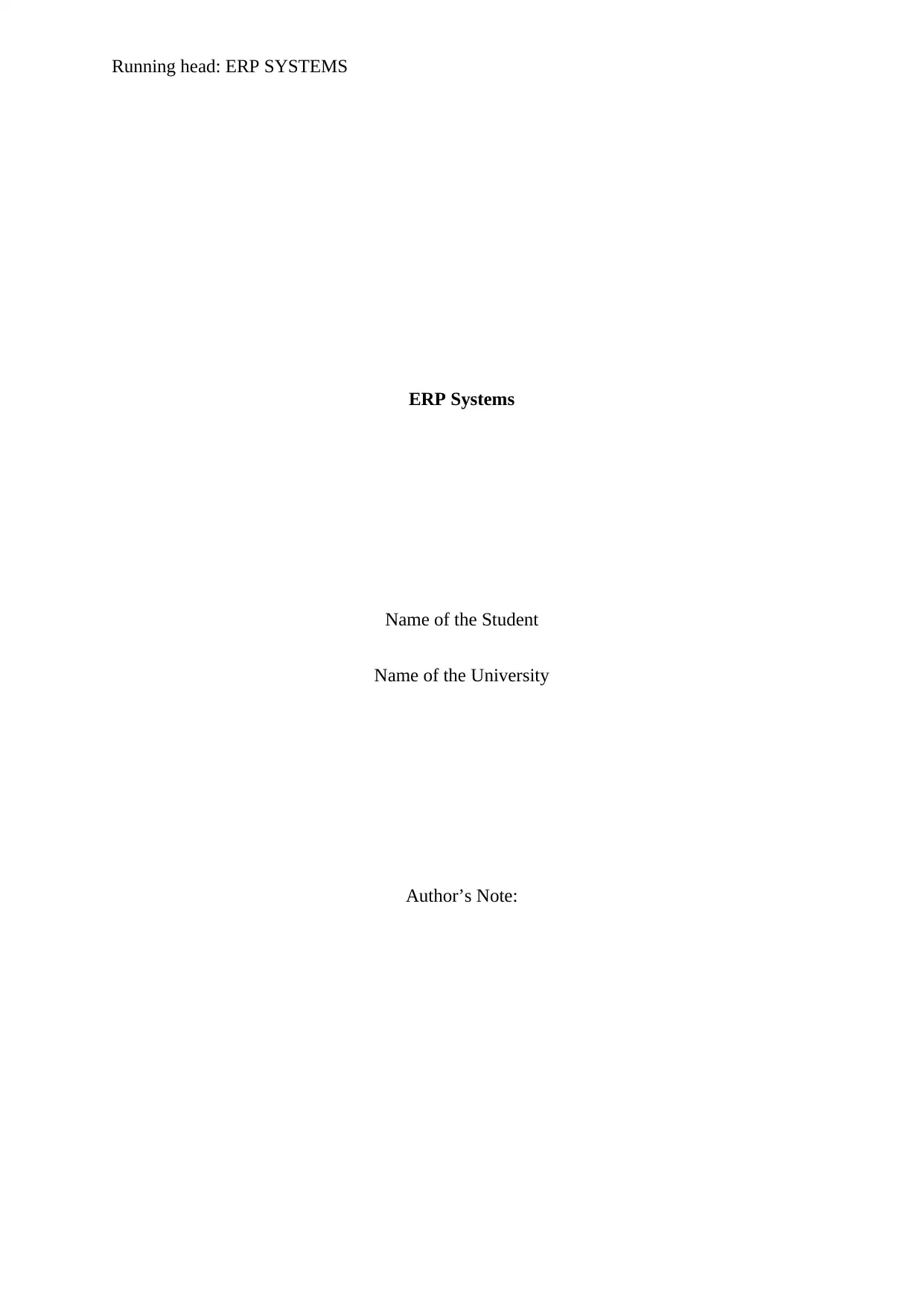
Running head: ERP SYSTEMS
ERP Systems
Name of the Student
Name of the University
Author’s Note:
ERP Systems
Name of the Student
Name of the University
Author’s Note:
Secure Best Marks with AI Grader
Need help grading? Try our AI Grader for instant feedback on your assignments.
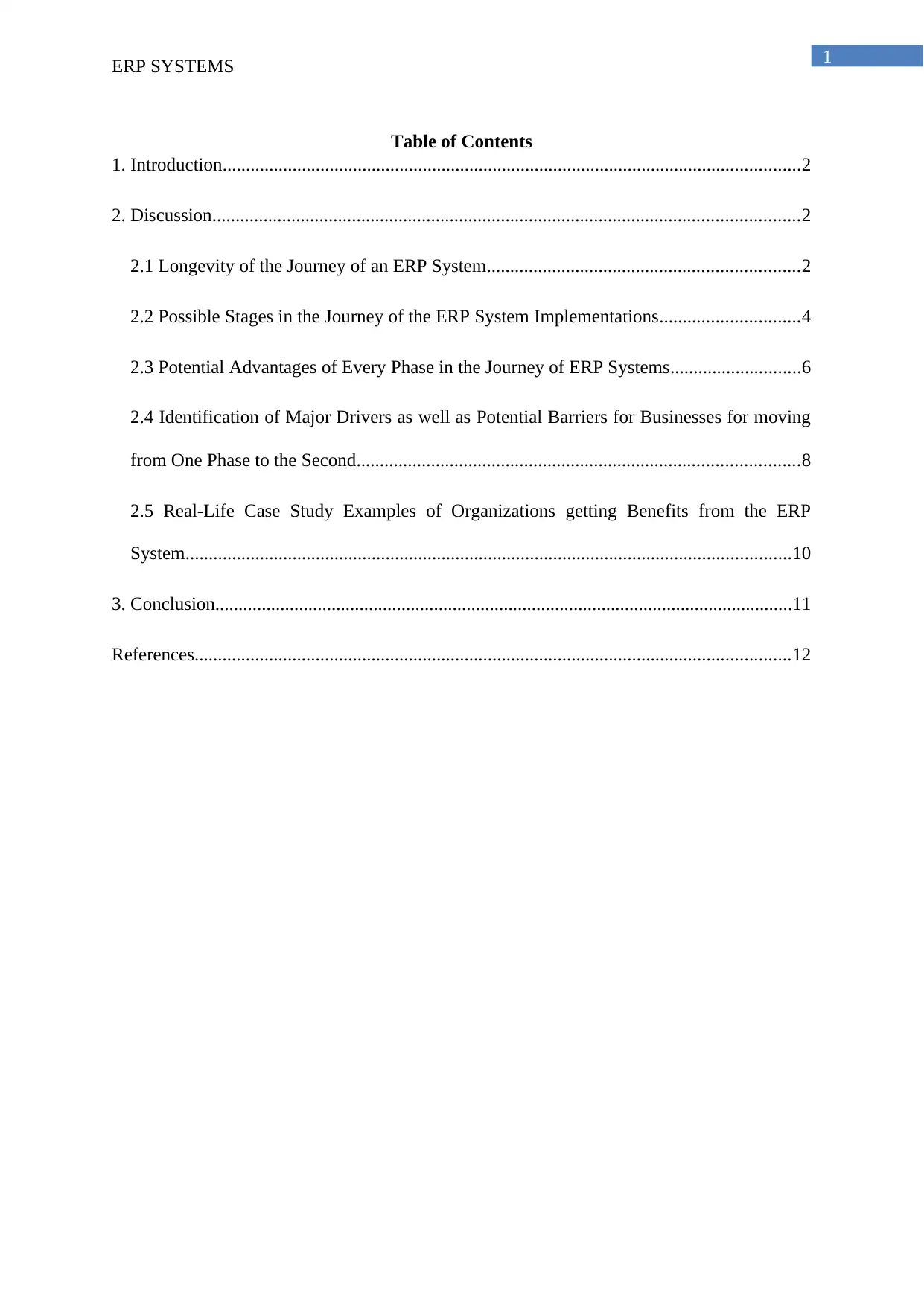
1
ERP SYSTEMS
Table of Contents
1. Introduction............................................................................................................................2
2. Discussion..............................................................................................................................2
2.1 Longevity of the Journey of an ERP System...................................................................2
2.2 Possible Stages in the Journey of the ERP System Implementations..............................4
2.3 Potential Advantages of Every Phase in the Journey of ERP Systems............................6
2.4 Identification of Major Drivers as well as Potential Barriers for Businesses for moving
from One Phase to the Second...............................................................................................8
2.5 Real-Life Case Study Examples of Organizations getting Benefits from the ERP
System..................................................................................................................................10
3. Conclusion............................................................................................................................11
References................................................................................................................................12
ERP SYSTEMS
Table of Contents
1. Introduction............................................................................................................................2
2. Discussion..............................................................................................................................2
2.1 Longevity of the Journey of an ERP System...................................................................2
2.2 Possible Stages in the Journey of the ERP System Implementations..............................4
2.3 Potential Advantages of Every Phase in the Journey of ERP Systems............................6
2.4 Identification of Major Drivers as well as Potential Barriers for Businesses for moving
from One Phase to the Second...............................................................................................8
2.5 Real-Life Case Study Examples of Organizations getting Benefits from the ERP
System..................................................................................................................................10
3. Conclusion............................................................................................................................11
References................................................................................................................................12
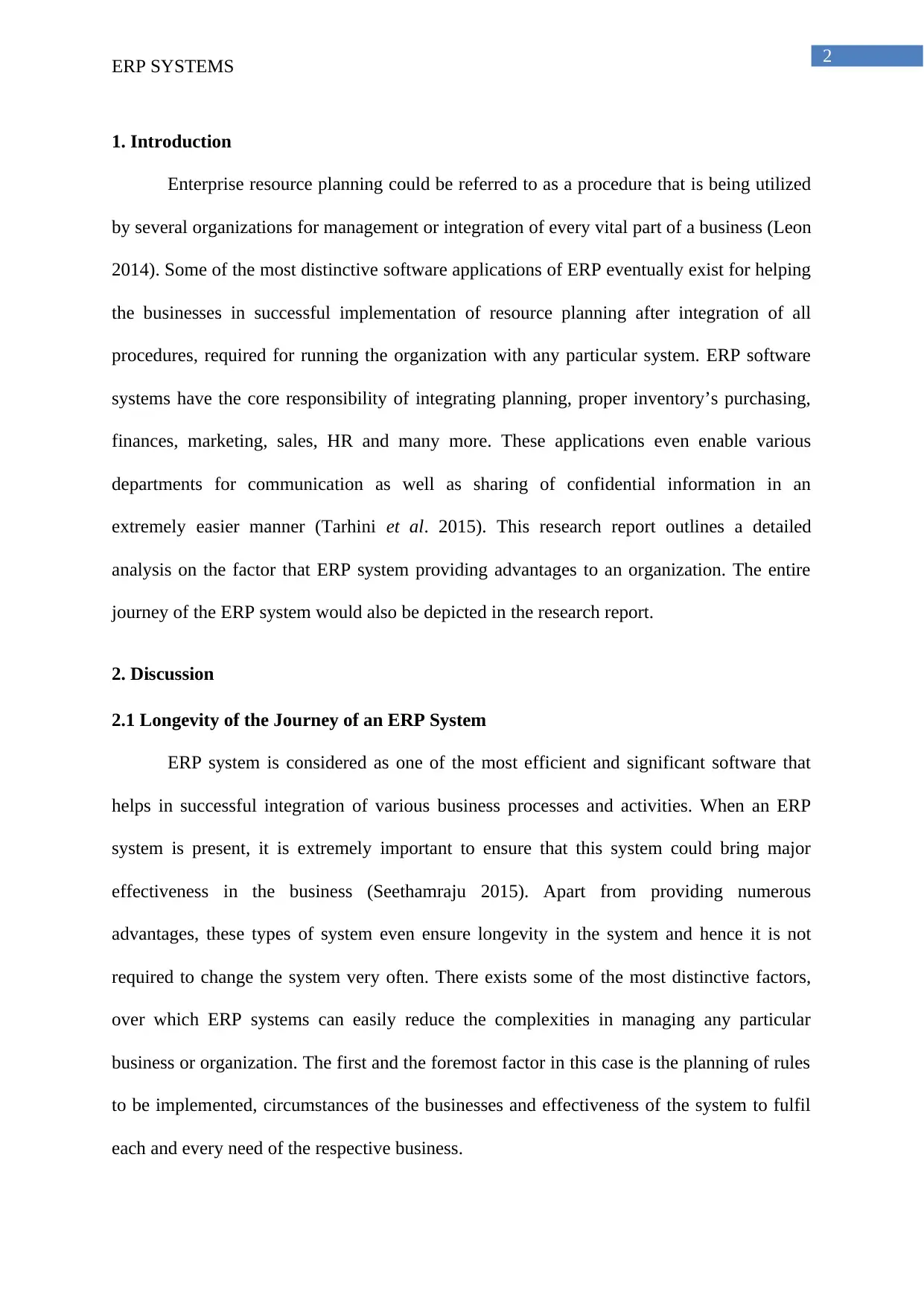
2
ERP SYSTEMS
1. Introduction
Enterprise resource planning could be referred to as a procedure that is being utilized
by several organizations for management or integration of every vital part of a business (Leon
2014). Some of the most distinctive software applications of ERP eventually exist for helping
the businesses in successful implementation of resource planning after integration of all
procedures, required for running the organization with any particular system. ERP software
systems have the core responsibility of integrating planning, proper inventory’s purchasing,
finances, marketing, sales, HR and many more. These applications even enable various
departments for communication as well as sharing of confidential information in an
extremely easier manner (Tarhini et al. 2015). This research report outlines a detailed
analysis on the factor that ERP system providing advantages to an organization. The entire
journey of the ERP system would also be depicted in the research report.
2. Discussion
2.1 Longevity of the Journey of an ERP System
ERP system is considered as one of the most efficient and significant software that
helps in successful integration of various business processes and activities. When an ERP
system is present, it is extremely important to ensure that this system could bring major
effectiveness in the business (Seethamraju 2015). Apart from providing numerous
advantages, these types of system even ensure longevity in the system and hence it is not
required to change the system very often. There exists some of the most distinctive factors,
over which ERP systems can easily reduce the complexities in managing any particular
business or organization. The first and the foremost factor in this case is the planning of rules
to be implemented, circumstances of the businesses and effectiveness of the system to fulfil
each and every need of the respective business.
ERP SYSTEMS
1. Introduction
Enterprise resource planning could be referred to as a procedure that is being utilized
by several organizations for management or integration of every vital part of a business (Leon
2014). Some of the most distinctive software applications of ERP eventually exist for helping
the businesses in successful implementation of resource planning after integration of all
procedures, required for running the organization with any particular system. ERP software
systems have the core responsibility of integrating planning, proper inventory’s purchasing,
finances, marketing, sales, HR and many more. These applications even enable various
departments for communication as well as sharing of confidential information in an
extremely easier manner (Tarhini et al. 2015). This research report outlines a detailed
analysis on the factor that ERP system providing advantages to an organization. The entire
journey of the ERP system would also be depicted in the research report.
2. Discussion
2.1 Longevity of the Journey of an ERP System
ERP system is considered as one of the most efficient and significant software that
helps in successful integration of various business processes and activities. When an ERP
system is present, it is extremely important to ensure that this system could bring major
effectiveness in the business (Seethamraju 2015). Apart from providing numerous
advantages, these types of system even ensure longevity in the system and hence it is not
required to change the system very often. There exists some of the most distinctive factors,
over which ERP systems can easily reduce the complexities in managing any particular
business or organization. The first and the foremost factor in this case is the planning of rules
to be implemented, circumstances of the businesses and effectiveness of the system to fulfil
each and every need of the respective business.
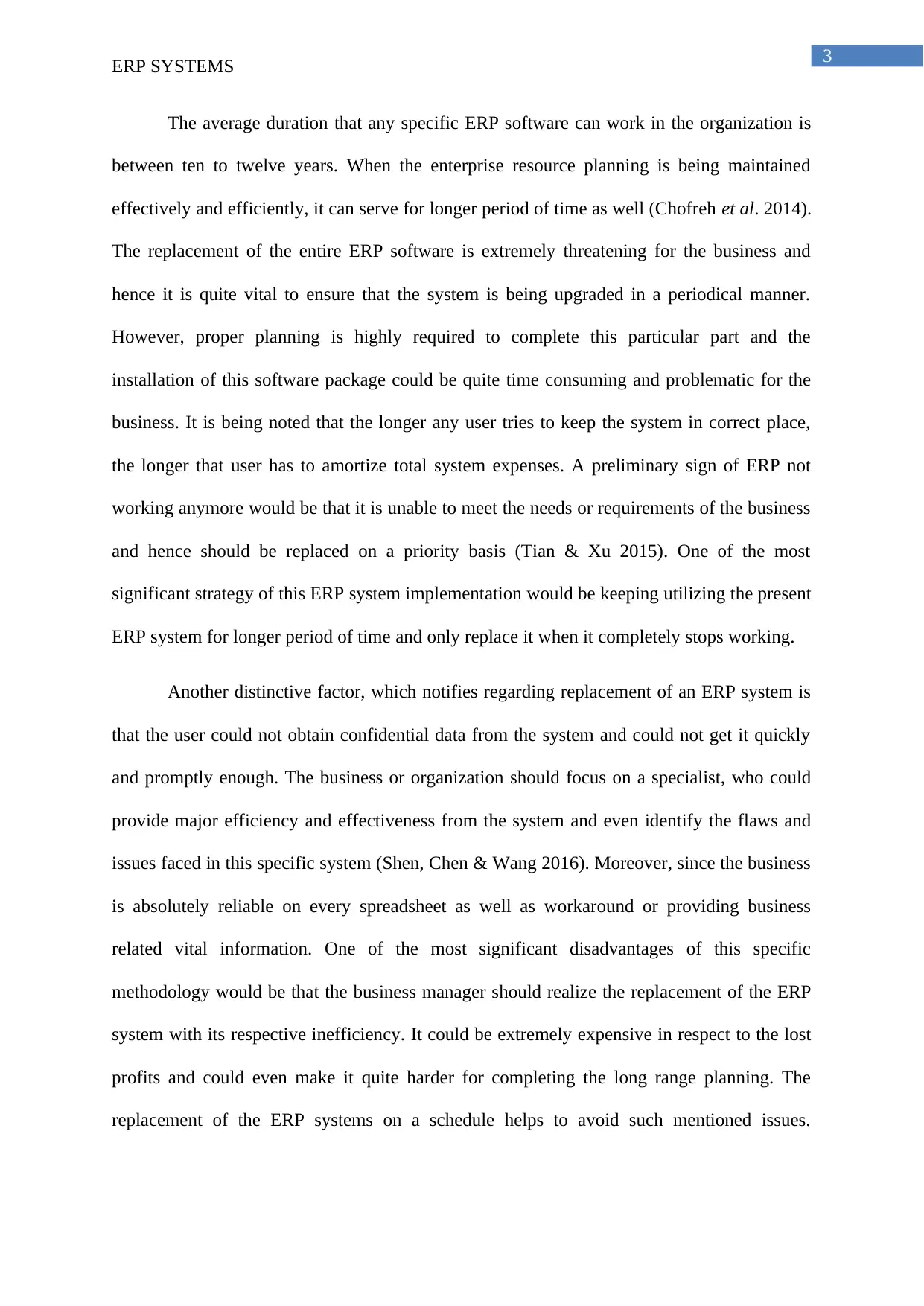
3
ERP SYSTEMS
The average duration that any specific ERP software can work in the organization is
between ten to twelve years. When the enterprise resource planning is being maintained
effectively and efficiently, it can serve for longer period of time as well (Chofreh et al. 2014).
The replacement of the entire ERP software is extremely threatening for the business and
hence it is quite vital to ensure that the system is being upgraded in a periodical manner.
However, proper planning is highly required to complete this particular part and the
installation of this software package could be quite time consuming and problematic for the
business. It is being noted that the longer any user tries to keep the system in correct place,
the longer that user has to amortize total system expenses. A preliminary sign of ERP not
working anymore would be that it is unable to meet the needs or requirements of the business
and hence should be replaced on a priority basis (Tian & Xu 2015). One of the most
significant strategy of this ERP system implementation would be keeping utilizing the present
ERP system for longer period of time and only replace it when it completely stops working.
Another distinctive factor, which notifies regarding replacement of an ERP system is
that the user could not obtain confidential data from the system and could not get it quickly
and promptly enough. The business or organization should focus on a specialist, who could
provide major efficiency and effectiveness from the system and even identify the flaws and
issues faced in this specific system (Shen, Chen & Wang 2016). Moreover, since the business
is absolutely reliable on every spreadsheet as well as workaround or providing business
related vital information. One of the most significant disadvantages of this specific
methodology would be that the business manager should realize the replacement of the ERP
system with its respective inefficiency. It could be extremely expensive in respect to the lost
profits and could even make it quite harder for completing the long range planning. The
replacement of the ERP systems on a schedule helps to avoid such mentioned issues.
ERP SYSTEMS
The average duration that any specific ERP software can work in the organization is
between ten to twelve years. When the enterprise resource planning is being maintained
effectively and efficiently, it can serve for longer period of time as well (Chofreh et al. 2014).
The replacement of the entire ERP software is extremely threatening for the business and
hence it is quite vital to ensure that the system is being upgraded in a periodical manner.
However, proper planning is highly required to complete this particular part and the
installation of this software package could be quite time consuming and problematic for the
business. It is being noted that the longer any user tries to keep the system in correct place,
the longer that user has to amortize total system expenses. A preliminary sign of ERP not
working anymore would be that it is unable to meet the needs or requirements of the business
and hence should be replaced on a priority basis (Tian & Xu 2015). One of the most
significant strategy of this ERP system implementation would be keeping utilizing the present
ERP system for longer period of time and only replace it when it completely stops working.
Another distinctive factor, which notifies regarding replacement of an ERP system is
that the user could not obtain confidential data from the system and could not get it quickly
and promptly enough. The business or organization should focus on a specialist, who could
provide major efficiency and effectiveness from the system and even identify the flaws and
issues faced in this specific system (Shen, Chen & Wang 2016). Moreover, since the business
is absolutely reliable on every spreadsheet as well as workaround or providing business
related vital information. One of the most significant disadvantages of this specific
methodology would be that the business manager should realize the replacement of the ERP
system with its respective inefficiency. It could be extremely expensive in respect to the lost
profits and could even make it quite harder for completing the long range planning. The
replacement of the ERP systems on a schedule helps to avoid such mentioned issues.
Secure Best Marks with AI Grader
Need help grading? Try our AI Grader for instant feedback on your assignments.
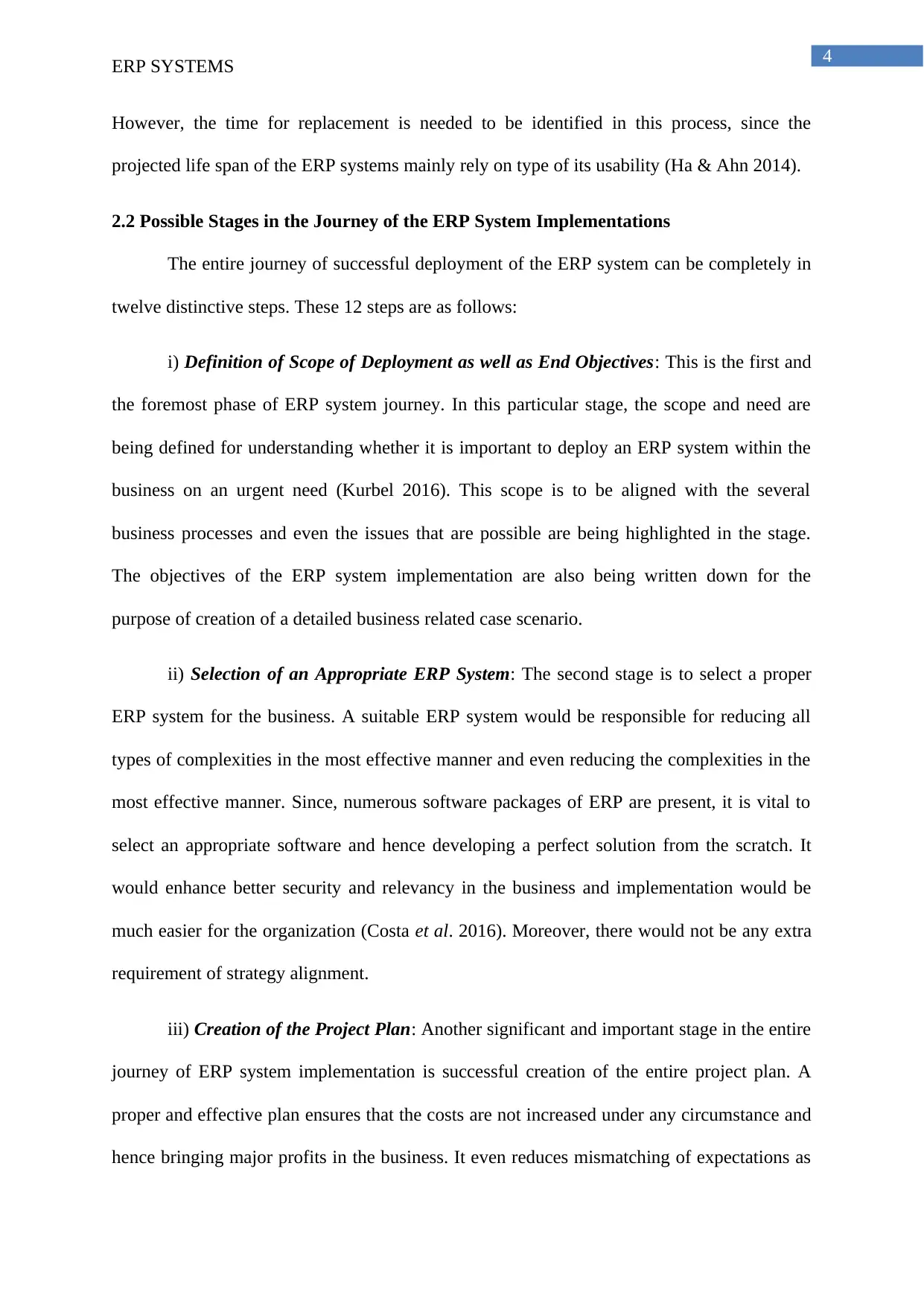
4
ERP SYSTEMS
However, the time for replacement is needed to be identified in this process, since the
projected life span of the ERP systems mainly rely on type of its usability (Ha & Ahn 2014).
2.2 Possible Stages in the Journey of the ERP System Implementations
The entire journey of successful deployment of the ERP system can be completely in
twelve distinctive steps. These 12 steps are as follows:
i) Definition of Scope of Deployment as well as End Objectives: This is the first and
the foremost phase of ERP system journey. In this particular stage, the scope and need are
being defined for understanding whether it is important to deploy an ERP system within the
business on an urgent need (Kurbel 2016). This scope is to be aligned with the several
business processes and even the issues that are possible are being highlighted in the stage.
The objectives of the ERP system implementation are also being written down for the
purpose of creation of a detailed business related case scenario.
ii) Selection of an Appropriate ERP System: The second stage is to select a proper
ERP system for the business. A suitable ERP system would be responsible for reducing all
types of complexities in the most effective manner and even reducing the complexities in the
most effective manner. Since, numerous software packages of ERP are present, it is vital to
select an appropriate software and hence developing a perfect solution from the scratch. It
would enhance better security and relevancy in the business and implementation would be
much easier for the organization (Costa et al. 2016). Moreover, there would not be any extra
requirement of strategy alignment.
iii) Creation of the Project Plan: Another significant and important stage in the entire
journey of ERP system implementation is successful creation of the entire project plan. A
proper and effective plan ensures that the costs are not increased under any circumstance and
hence bringing major profits in the business. It even reduces mismatching of expectations as
ERP SYSTEMS
However, the time for replacement is needed to be identified in this process, since the
projected life span of the ERP systems mainly rely on type of its usability (Ha & Ahn 2014).
2.2 Possible Stages in the Journey of the ERP System Implementations
The entire journey of successful deployment of the ERP system can be completely in
twelve distinctive steps. These 12 steps are as follows:
i) Definition of Scope of Deployment as well as End Objectives: This is the first and
the foremost phase of ERP system journey. In this particular stage, the scope and need are
being defined for understanding whether it is important to deploy an ERP system within the
business on an urgent need (Kurbel 2016). This scope is to be aligned with the several
business processes and even the issues that are possible are being highlighted in the stage.
The objectives of the ERP system implementation are also being written down for the
purpose of creation of a detailed business related case scenario.
ii) Selection of an Appropriate ERP System: The second stage is to select a proper
ERP system for the business. A suitable ERP system would be responsible for reducing all
types of complexities in the most effective manner and even reducing the complexities in the
most effective manner. Since, numerous software packages of ERP are present, it is vital to
select an appropriate software and hence developing a perfect solution from the scratch. It
would enhance better security and relevancy in the business and implementation would be
much easier for the organization (Costa et al. 2016). Moreover, there would not be any extra
requirement of strategy alignment.
iii) Creation of the Project Plan: Another significant and important stage in the entire
journey of ERP system implementation is successful creation of the entire project plan. A
proper and effective plan ensures that the costs are not increased under any circumstance and
hence bringing major profits in the business. It even reduces mismatching of expectations as
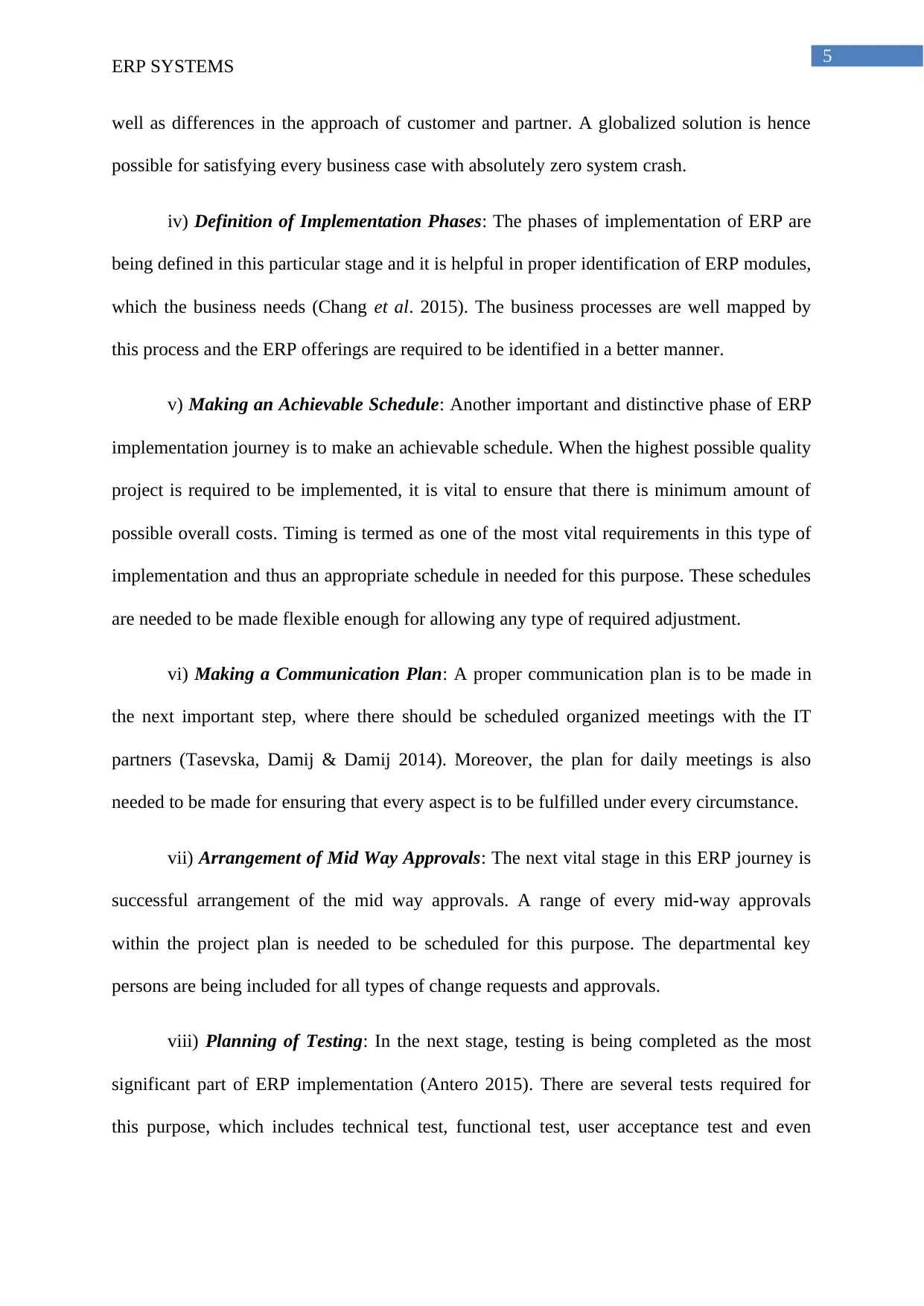
5
ERP SYSTEMS
well as differences in the approach of customer and partner. A globalized solution is hence
possible for satisfying every business case with absolutely zero system crash.
iv) Definition of Implementation Phases: The phases of implementation of ERP are
being defined in this particular stage and it is helpful in proper identification of ERP modules,
which the business needs (Chang et al. 2015). The business processes are well mapped by
this process and the ERP offerings are required to be identified in a better manner.
v) Making an Achievable Schedule: Another important and distinctive phase of ERP
implementation journey is to make an achievable schedule. When the highest possible quality
project is required to be implemented, it is vital to ensure that there is minimum amount of
possible overall costs. Timing is termed as one of the most vital requirements in this type of
implementation and thus an appropriate schedule in needed for this purpose. These schedules
are needed to be made flexible enough for allowing any type of required adjustment.
vi) Making a Communication Plan: A proper communication plan is to be made in
the next important step, where there should be scheduled organized meetings with the IT
partners (Tasevska, Damij & Damij 2014). Moreover, the plan for daily meetings is also
needed to be made for ensuring that every aspect is to be fulfilled under every circumstance.
vii) Arrangement of Mid Way Approvals: The next vital stage in this ERP journey is
successful arrangement of the mid way approvals. A range of every mid-way approvals
within the project plan is needed to be scheduled for this purpose. The departmental key
persons are being included for all types of change requests and approvals.
viii) Planning of Testing: In the next stage, testing is being completed as the most
significant part of ERP implementation (Antero 2015). There are several tests required for
this purpose, which includes technical test, functional test, user acceptance test and even
ERP SYSTEMS
well as differences in the approach of customer and partner. A globalized solution is hence
possible for satisfying every business case with absolutely zero system crash.
iv) Definition of Implementation Phases: The phases of implementation of ERP are
being defined in this particular stage and it is helpful in proper identification of ERP modules,
which the business needs (Chang et al. 2015). The business processes are well mapped by
this process and the ERP offerings are required to be identified in a better manner.
v) Making an Achievable Schedule: Another important and distinctive phase of ERP
implementation journey is to make an achievable schedule. When the highest possible quality
project is required to be implemented, it is vital to ensure that there is minimum amount of
possible overall costs. Timing is termed as one of the most vital requirements in this type of
implementation and thus an appropriate schedule in needed for this purpose. These schedules
are needed to be made flexible enough for allowing any type of required adjustment.
vi) Making a Communication Plan: A proper communication plan is to be made in
the next important step, where there should be scheduled organized meetings with the IT
partners (Tasevska, Damij & Damij 2014). Moreover, the plan for daily meetings is also
needed to be made for ensuring that every aspect is to be fulfilled under every circumstance.
vii) Arrangement of Mid Way Approvals: The next vital stage in this ERP journey is
successful arrangement of the mid way approvals. A range of every mid-way approvals
within the project plan is needed to be scheduled for this purpose. The departmental key
persons are being included for all types of change requests and approvals.
viii) Planning of Testing: In the next stage, testing is being completed as the most
significant part of ERP implementation (Antero 2015). There are several tests required for
this purpose, which includes technical test, functional test, user acceptance test and even
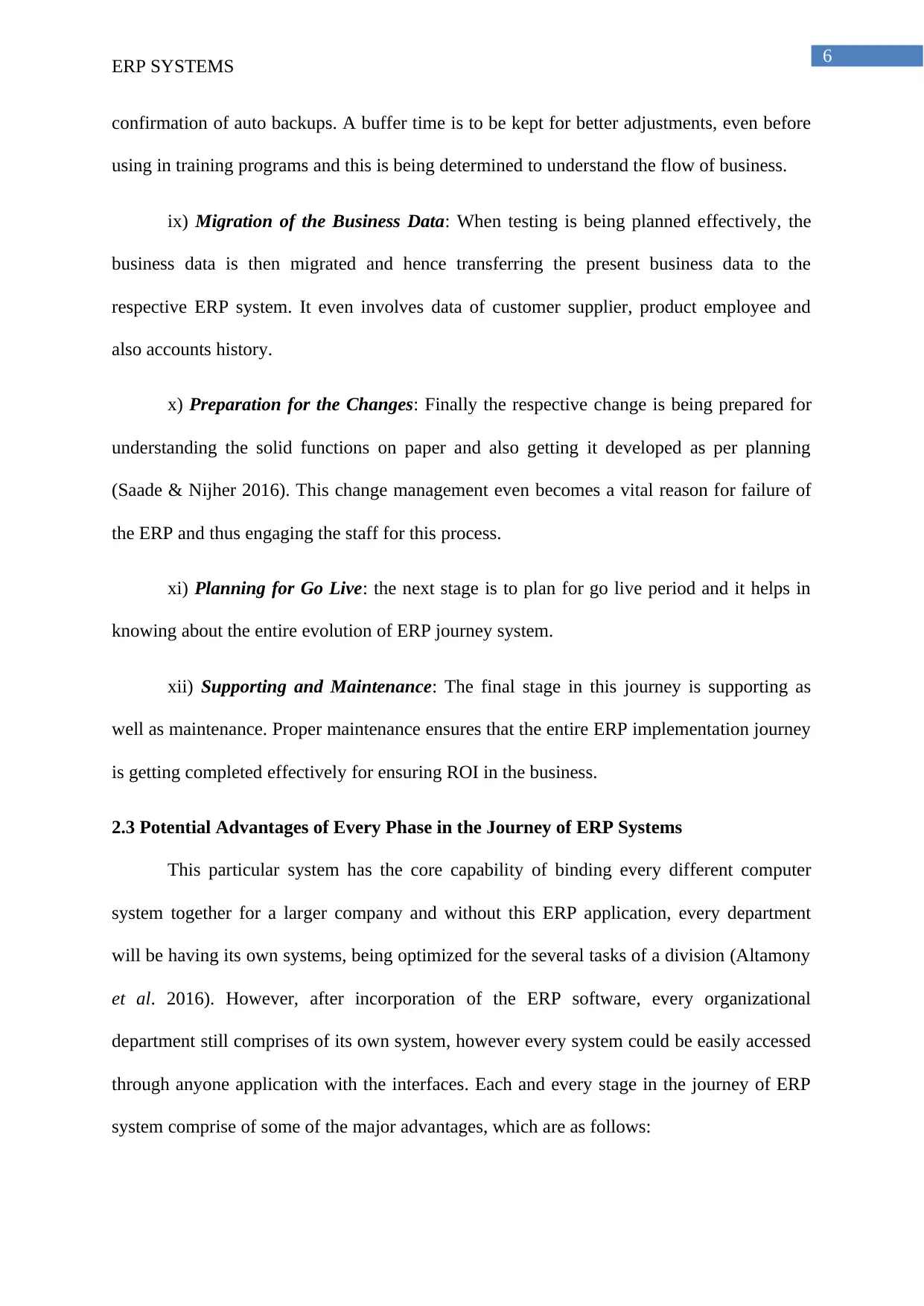
6
ERP SYSTEMS
confirmation of auto backups. A buffer time is to be kept for better adjustments, even before
using in training programs and this is being determined to understand the flow of business.
ix) Migration of the Business Data: When testing is being planned effectively, the
business data is then migrated and hence transferring the present business data to the
respective ERP system. It even involves data of customer supplier, product employee and
also accounts history.
x) Preparation for the Changes: Finally the respective change is being prepared for
understanding the solid functions on paper and also getting it developed as per planning
(Saade & Nijher 2016). This change management even becomes a vital reason for failure of
the ERP and thus engaging the staff for this process.
xi) Planning for Go Live: the next stage is to plan for go live period and it helps in
knowing about the entire evolution of ERP journey system.
xii) Supporting and Maintenance: The final stage in this journey is supporting as
well as maintenance. Proper maintenance ensures that the entire ERP implementation journey
is getting completed effectively for ensuring ROI in the business.
2.3 Potential Advantages of Every Phase in the Journey of ERP Systems
This particular system has the core capability of binding every different computer
system together for a larger company and without this ERP application, every department
will be having its own systems, being optimized for the several tasks of a division (Altamony
et al. 2016). However, after incorporation of the ERP software, every organizational
department still comprises of its own system, however every system could be easily accessed
through anyone application with the interfaces. Each and every stage in the journey of ERP
system comprise of some of the major advantages, which are as follows:
ERP SYSTEMS
confirmation of auto backups. A buffer time is to be kept for better adjustments, even before
using in training programs and this is being determined to understand the flow of business.
ix) Migration of the Business Data: When testing is being planned effectively, the
business data is then migrated and hence transferring the present business data to the
respective ERP system. It even involves data of customer supplier, product employee and
also accounts history.
x) Preparation for the Changes: Finally the respective change is being prepared for
understanding the solid functions on paper and also getting it developed as per planning
(Saade & Nijher 2016). This change management even becomes a vital reason for failure of
the ERP and thus engaging the staff for this process.
xi) Planning for Go Live: the next stage is to plan for go live period and it helps in
knowing about the entire evolution of ERP journey system.
xii) Supporting and Maintenance: The final stage in this journey is supporting as
well as maintenance. Proper maintenance ensures that the entire ERP implementation journey
is getting completed effectively for ensuring ROI in the business.
2.3 Potential Advantages of Every Phase in the Journey of ERP Systems
This particular system has the core capability of binding every different computer
system together for a larger company and without this ERP application, every department
will be having its own systems, being optimized for the several tasks of a division (Altamony
et al. 2016). However, after incorporation of the ERP software, every organizational
department still comprises of its own system, however every system could be easily accessed
through anyone application with the interfaces. Each and every stage in the journey of ERP
system comprise of some of the major advantages, which are as follows:
Paraphrase This Document
Need a fresh take? Get an instant paraphrase of this document with our AI Paraphraser
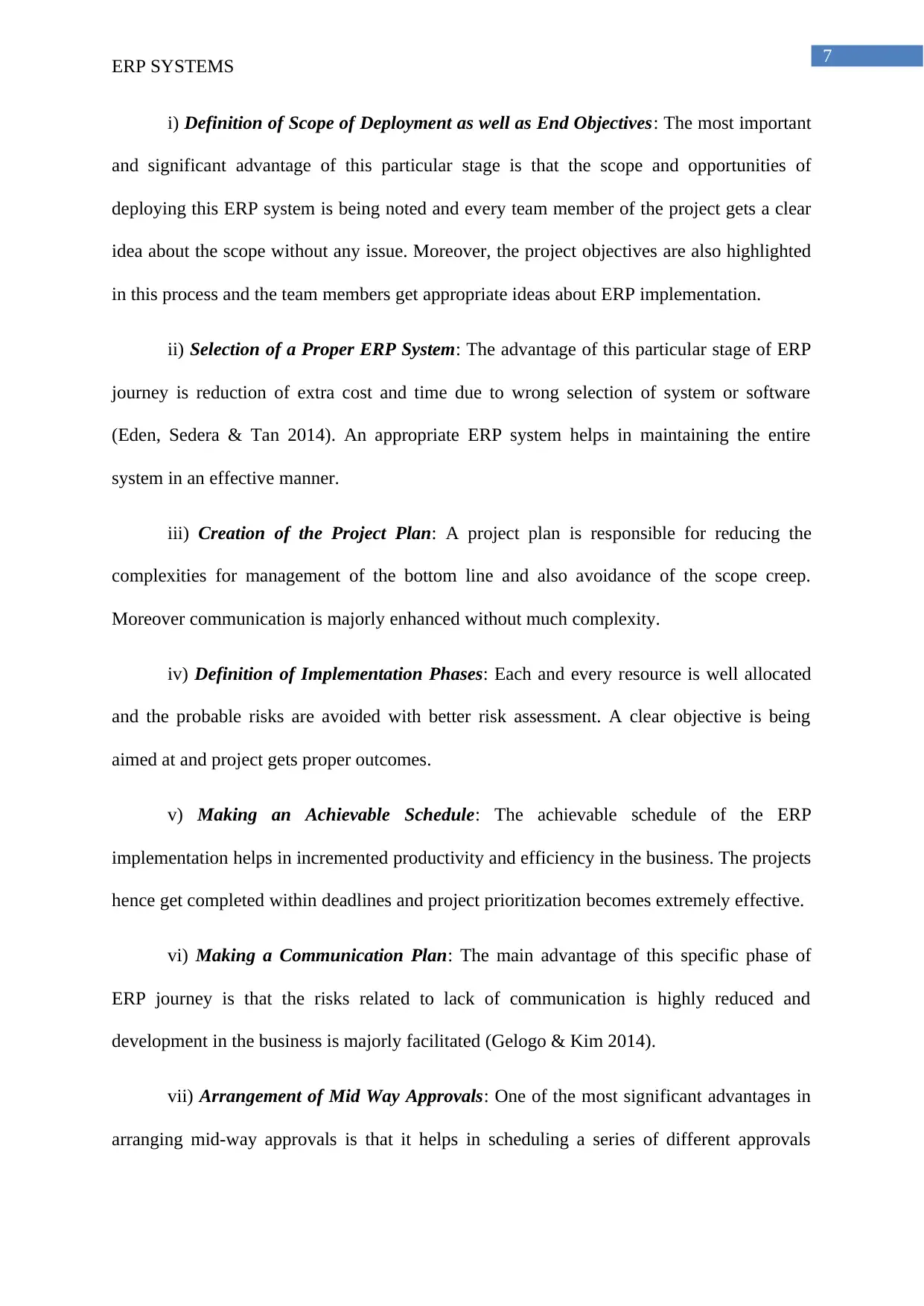
7
ERP SYSTEMS
i) Definition of Scope of Deployment as well as End Objectives: The most important
and significant advantage of this particular stage is that the scope and opportunities of
deploying this ERP system is being noted and every team member of the project gets a clear
idea about the scope without any issue. Moreover, the project objectives are also highlighted
in this process and the team members get appropriate ideas about ERP implementation.
ii) Selection of a Proper ERP System: The advantage of this particular stage of ERP
journey is reduction of extra cost and time due to wrong selection of system or software
(Eden, Sedera & Tan 2014). An appropriate ERP system helps in maintaining the entire
system in an effective manner.
iii) Creation of the Project Plan: A project plan is responsible for reducing the
complexities for management of the bottom line and also avoidance of the scope creep.
Moreover communication is majorly enhanced without much complexity.
iv) Definition of Implementation Phases: Each and every resource is well allocated
and the probable risks are avoided with better risk assessment. A clear objective is being
aimed at and project gets proper outcomes.
v) Making an Achievable Schedule: The achievable schedule of the ERP
implementation helps in incremented productivity and efficiency in the business. The projects
hence get completed within deadlines and project prioritization becomes extremely effective.
vi) Making a Communication Plan: The main advantage of this specific phase of
ERP journey is that the risks related to lack of communication is highly reduced and
development in the business is majorly facilitated (Gelogo & Kim 2014).
vii) Arrangement of Mid Way Approvals: One of the most significant advantages in
arranging mid-way approvals is that it helps in scheduling a series of different approvals
ERP SYSTEMS
i) Definition of Scope of Deployment as well as End Objectives: The most important
and significant advantage of this particular stage is that the scope and opportunities of
deploying this ERP system is being noted and every team member of the project gets a clear
idea about the scope without any issue. Moreover, the project objectives are also highlighted
in this process and the team members get appropriate ideas about ERP implementation.
ii) Selection of a Proper ERP System: The advantage of this particular stage of ERP
journey is reduction of extra cost and time due to wrong selection of system or software
(Eden, Sedera & Tan 2014). An appropriate ERP system helps in maintaining the entire
system in an effective manner.
iii) Creation of the Project Plan: A project plan is responsible for reducing the
complexities for management of the bottom line and also avoidance of the scope creep.
Moreover communication is majorly enhanced without much complexity.
iv) Definition of Implementation Phases: Each and every resource is well allocated
and the probable risks are avoided with better risk assessment. A clear objective is being
aimed at and project gets proper outcomes.
v) Making an Achievable Schedule: The achievable schedule of the ERP
implementation helps in incremented productivity and efficiency in the business. The projects
hence get completed within deadlines and project prioritization becomes extremely effective.
vi) Making a Communication Plan: The main advantage of this specific phase of
ERP journey is that the risks related to lack of communication is highly reduced and
development in the business is majorly facilitated (Gelogo & Kim 2014).
vii) Arrangement of Mid Way Approvals: One of the most significant advantages in
arranging mid-way approvals is that it helps in scheduling a series of different approvals
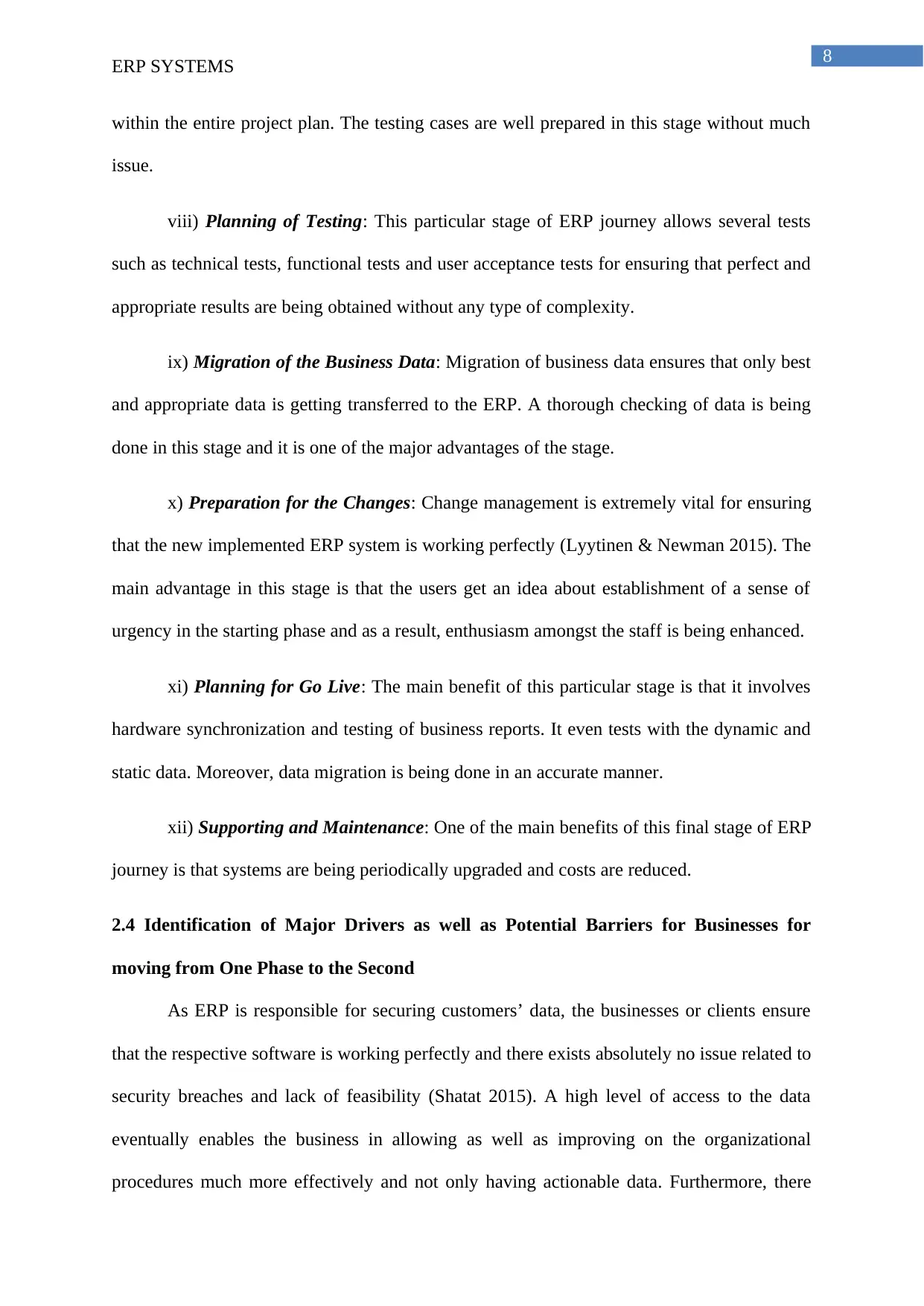
8
ERP SYSTEMS
within the entire project plan. The testing cases are well prepared in this stage without much
issue.
viii) Planning of Testing: This particular stage of ERP journey allows several tests
such as technical tests, functional tests and user acceptance tests for ensuring that perfect and
appropriate results are being obtained without any type of complexity.
ix) Migration of the Business Data: Migration of business data ensures that only best
and appropriate data is getting transferred to the ERP. A thorough checking of data is being
done in this stage and it is one of the major advantages of the stage.
x) Preparation for the Changes: Change management is extremely vital for ensuring
that the new implemented ERP system is working perfectly (Lyytinen & Newman 2015). The
main advantage in this stage is that the users get an idea about establishment of a sense of
urgency in the starting phase and as a result, enthusiasm amongst the staff is being enhanced.
xi) Planning for Go Live: The main benefit of this particular stage is that it involves
hardware synchronization and testing of business reports. It even tests with the dynamic and
static data. Moreover, data migration is being done in an accurate manner.
xii) Supporting and Maintenance: One of the main benefits of this final stage of ERP
journey is that systems are being periodically upgraded and costs are reduced.
2.4 Identification of Major Drivers as well as Potential Barriers for Businesses for
moving from One Phase to the Second
As ERP is responsible for securing customers’ data, the businesses or clients ensure
that the respective software is working perfectly and there exists absolutely no issue related to
security breaches and lack of feasibility (Shatat 2015). A high level of access to the data
eventually enables the business in allowing as well as improving on the organizational
procedures much more effectively and not only having actionable data. Furthermore, there
ERP SYSTEMS
within the entire project plan. The testing cases are well prepared in this stage without much
issue.
viii) Planning of Testing: This particular stage of ERP journey allows several tests
such as technical tests, functional tests and user acceptance tests for ensuring that perfect and
appropriate results are being obtained without any type of complexity.
ix) Migration of the Business Data: Migration of business data ensures that only best
and appropriate data is getting transferred to the ERP. A thorough checking of data is being
done in this stage and it is one of the major advantages of the stage.
x) Preparation for the Changes: Change management is extremely vital for ensuring
that the new implemented ERP system is working perfectly (Lyytinen & Newman 2015). The
main advantage in this stage is that the users get an idea about establishment of a sense of
urgency in the starting phase and as a result, enthusiasm amongst the staff is being enhanced.
xi) Planning for Go Live: The main benefit of this particular stage is that it involves
hardware synchronization and testing of business reports. It even tests with the dynamic and
static data. Moreover, data migration is being done in an accurate manner.
xii) Supporting and Maintenance: One of the main benefits of this final stage of ERP
journey is that systems are being periodically upgraded and costs are reduced.
2.4 Identification of Major Drivers as well as Potential Barriers for Businesses for
moving from One Phase to the Second
As ERP is responsible for securing customers’ data, the businesses or clients ensure
that the respective software is working perfectly and there exists absolutely no issue related to
security breaches and lack of feasibility (Shatat 2015). A high level of access to the data
eventually enables the business in allowing as well as improving on the organizational
procedures much more effectively and not only having actionable data. Furthermore, there
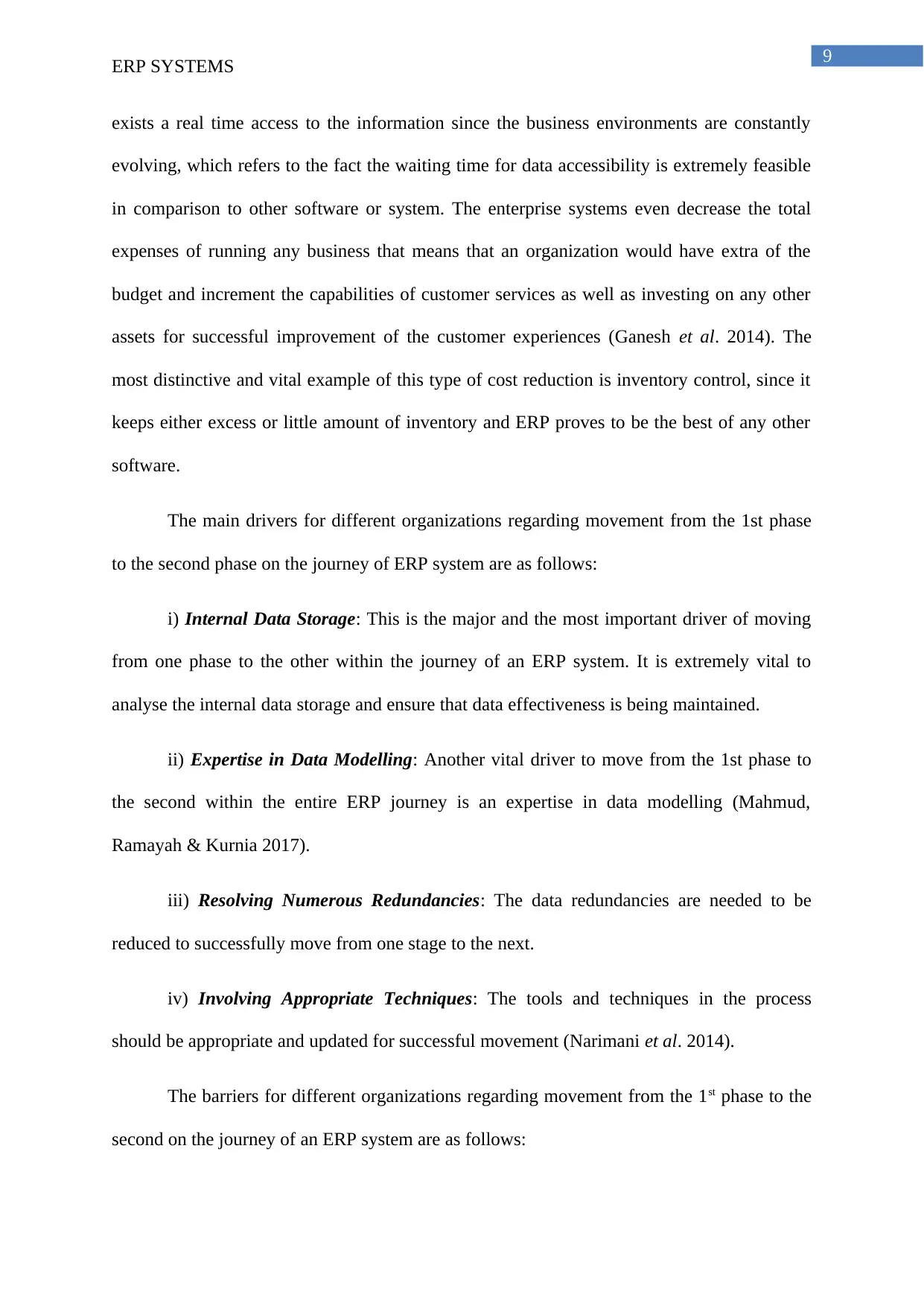
9
ERP SYSTEMS
exists a real time access to the information since the business environments are constantly
evolving, which refers to the fact the waiting time for data accessibility is extremely feasible
in comparison to other software or system. The enterprise systems even decrease the total
expenses of running any business that means that an organization would have extra of the
budget and increment the capabilities of customer services as well as investing on any other
assets for successful improvement of the customer experiences (Ganesh et al. 2014). The
most distinctive and vital example of this type of cost reduction is inventory control, since it
keeps either excess or little amount of inventory and ERP proves to be the best of any other
software.
The main drivers for different organizations regarding movement from the 1st phase
to the second phase on the journey of ERP system are as follows:
i) Internal Data Storage: This is the major and the most important driver of moving
from one phase to the other within the journey of an ERP system. It is extremely vital to
analyse the internal data storage and ensure that data effectiveness is being maintained.
ii) Expertise in Data Modelling: Another vital driver to move from the 1st phase to
the second within the entire ERP journey is an expertise in data modelling (Mahmud,
Ramayah & Kurnia 2017).
iii) Resolving Numerous Redundancies: The data redundancies are needed to be
reduced to successfully move from one stage to the next.
iv) Involving Appropriate Techniques: The tools and techniques in the process
should be appropriate and updated for successful movement (Narimani et al. 2014).
The barriers for different organizations regarding movement from the 1st phase to the
second on the journey of an ERP system are as follows:
ERP SYSTEMS
exists a real time access to the information since the business environments are constantly
evolving, which refers to the fact the waiting time for data accessibility is extremely feasible
in comparison to other software or system. The enterprise systems even decrease the total
expenses of running any business that means that an organization would have extra of the
budget and increment the capabilities of customer services as well as investing on any other
assets for successful improvement of the customer experiences (Ganesh et al. 2014). The
most distinctive and vital example of this type of cost reduction is inventory control, since it
keeps either excess or little amount of inventory and ERP proves to be the best of any other
software.
The main drivers for different organizations regarding movement from the 1st phase
to the second phase on the journey of ERP system are as follows:
i) Internal Data Storage: This is the major and the most important driver of moving
from one phase to the other within the journey of an ERP system. It is extremely vital to
analyse the internal data storage and ensure that data effectiveness is being maintained.
ii) Expertise in Data Modelling: Another vital driver to move from the 1st phase to
the second within the entire ERP journey is an expertise in data modelling (Mahmud,
Ramayah & Kurnia 2017).
iii) Resolving Numerous Redundancies: The data redundancies are needed to be
reduced to successfully move from one stage to the next.
iv) Involving Appropriate Techniques: The tools and techniques in the process
should be appropriate and updated for successful movement (Narimani et al. 2014).
The barriers for different organizations regarding movement from the 1st phase to the
second on the journey of an ERP system are as follows:
Secure Best Marks with AI Grader
Need help grading? Try our AI Grader for instant feedback on your assignments.
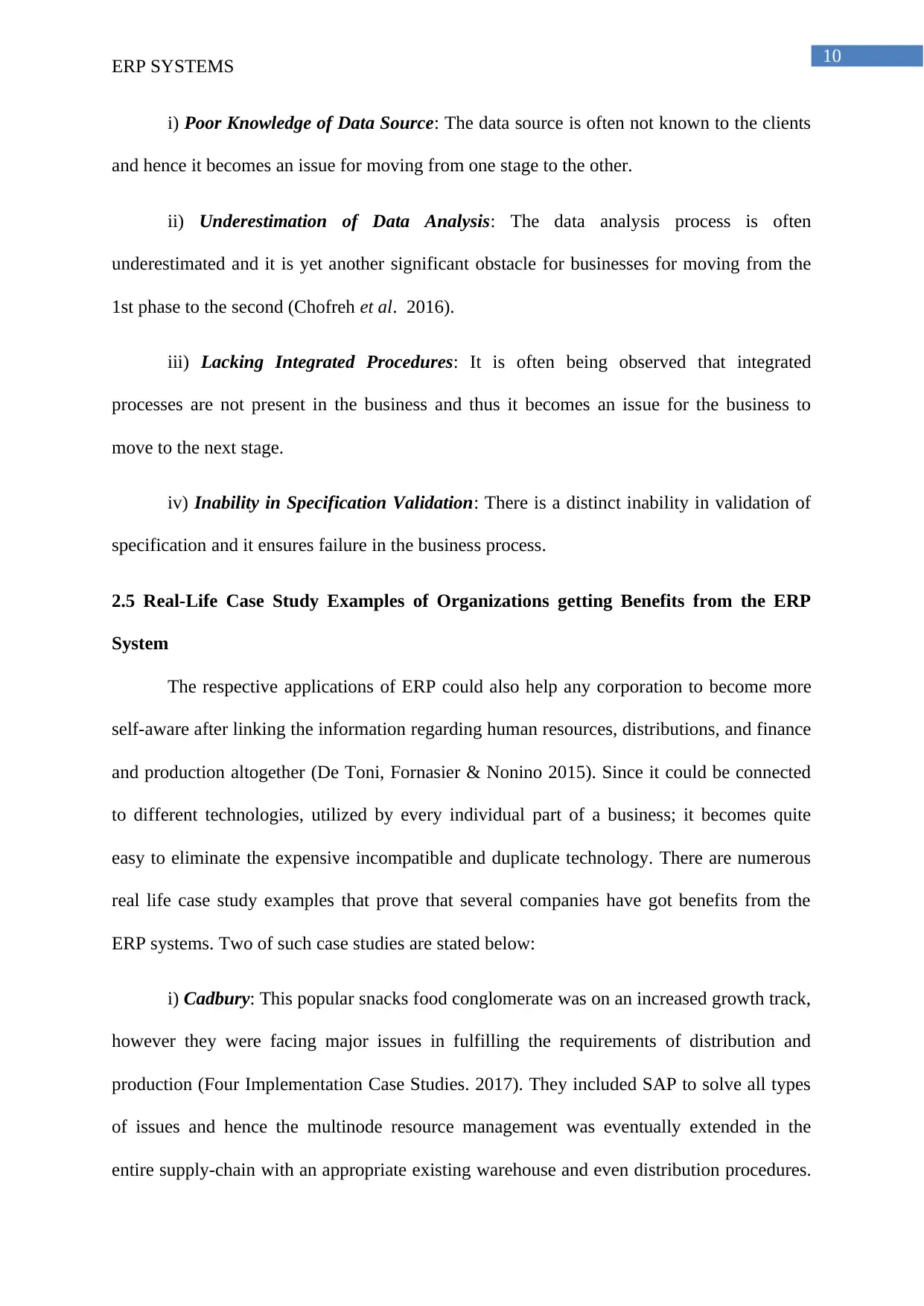
10
ERP SYSTEMS
i) Poor Knowledge of Data Source: The data source is often not known to the clients
and hence it becomes an issue for moving from one stage to the other.
ii) Underestimation of Data Analysis: The data analysis process is often
underestimated and it is yet another significant obstacle for businesses for moving from the
1st phase to the second (Chofreh et al. 2016).
iii) Lacking Integrated Procedures: It is often being observed that integrated
processes are not present in the business and thus it becomes an issue for the business to
move to the next stage.
iv) Inability in Specification Validation: There is a distinct inability in validation of
specification and it ensures failure in the business process.
2.5 Real-Life Case Study Examples of Organizations getting Benefits from the ERP
System
The respective applications of ERP could also help any corporation to become more
self-aware after linking the information regarding human resources, distributions, and finance
and production altogether (De Toni, Fornasier & Nonino 2015). Since it could be connected
to different technologies, utilized by every individual part of a business; it becomes quite
easy to eliminate the expensive incompatible and duplicate technology. There are numerous
real life case study examples that prove that several companies have got benefits from the
ERP systems. Two of such case studies are stated below:
i) Cadbury: This popular snacks food conglomerate was on an increased growth track,
however they were facing major issues in fulfilling the requirements of distribution and
production (Four Implementation Case Studies. 2017). They included SAP to solve all types
of issues and hence the multinode resource management was eventually extended in the
entire supply-chain with an appropriate existing warehouse and even distribution procedures.
ERP SYSTEMS
i) Poor Knowledge of Data Source: The data source is often not known to the clients
and hence it becomes an issue for moving from one stage to the other.
ii) Underestimation of Data Analysis: The data analysis process is often
underestimated and it is yet another significant obstacle for businesses for moving from the
1st phase to the second (Chofreh et al. 2016).
iii) Lacking Integrated Procedures: It is often being observed that integrated
processes are not present in the business and thus it becomes an issue for the business to
move to the next stage.
iv) Inability in Specification Validation: There is a distinct inability in validation of
specification and it ensures failure in the business process.
2.5 Real-Life Case Study Examples of Organizations getting Benefits from the ERP
System
The respective applications of ERP could also help any corporation to become more
self-aware after linking the information regarding human resources, distributions, and finance
and production altogether (De Toni, Fornasier & Nonino 2015). Since it could be connected
to different technologies, utilized by every individual part of a business; it becomes quite
easy to eliminate the expensive incompatible and duplicate technology. There are numerous
real life case study examples that prove that several companies have got benefits from the
ERP systems. Two of such case studies are stated below:
i) Cadbury: This popular snacks food conglomerate was on an increased growth track,
however they were facing major issues in fulfilling the requirements of distribution and
production (Four Implementation Case Studies. 2017). They included SAP to solve all types
of issues and hence the multinode resource management was eventually extended in the
entire supply-chain with an appropriate existing warehouse and even distribution procedures.
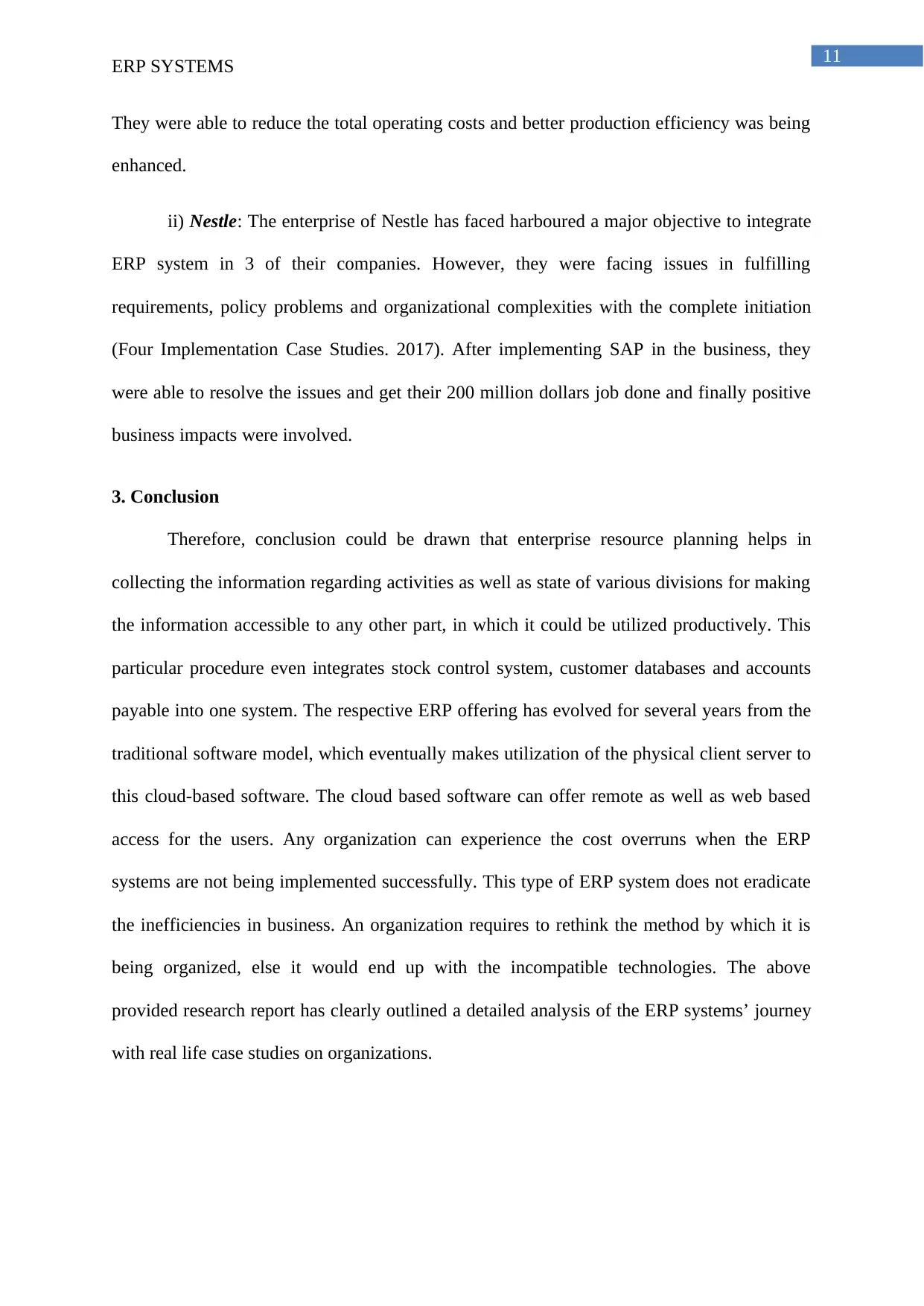
11
ERP SYSTEMS
They were able to reduce the total operating costs and better production efficiency was being
enhanced.
ii) Nestle: The enterprise of Nestle has faced harboured a major objective to integrate
ERP system in 3 of their companies. However, they were facing issues in fulfilling
requirements, policy problems and organizational complexities with the complete initiation
(Four Implementation Case Studies. 2017). After implementing SAP in the business, they
were able to resolve the issues and get their 200 million dollars job done and finally positive
business impacts were involved.
3. Conclusion
Therefore, conclusion could be drawn that enterprise resource planning helps in
collecting the information regarding activities as well as state of various divisions for making
the information accessible to any other part, in which it could be utilized productively. This
particular procedure even integrates stock control system, customer databases and accounts
payable into one system. The respective ERP offering has evolved for several years from the
traditional software model, which eventually makes utilization of the physical client server to
this cloud-based software. The cloud based software can offer remote as well as web based
access for the users. Any organization can experience the cost overruns when the ERP
systems are not being implemented successfully. This type of ERP system does not eradicate
the inefficiencies in business. An organization requires to rethink the method by which it is
being organized, else it would end up with the incompatible technologies. The above
provided research report has clearly outlined a detailed analysis of the ERP systems’ journey
with real life case studies on organizations.
ERP SYSTEMS
They were able to reduce the total operating costs and better production efficiency was being
enhanced.
ii) Nestle: The enterprise of Nestle has faced harboured a major objective to integrate
ERP system in 3 of their companies. However, they were facing issues in fulfilling
requirements, policy problems and organizational complexities with the complete initiation
(Four Implementation Case Studies. 2017). After implementing SAP in the business, they
were able to resolve the issues and get their 200 million dollars job done and finally positive
business impacts were involved.
3. Conclusion
Therefore, conclusion could be drawn that enterprise resource planning helps in
collecting the information regarding activities as well as state of various divisions for making
the information accessible to any other part, in which it could be utilized productively. This
particular procedure even integrates stock control system, customer databases and accounts
payable into one system. The respective ERP offering has evolved for several years from the
traditional software model, which eventually makes utilization of the physical client server to
this cloud-based software. The cloud based software can offer remote as well as web based
access for the users. Any organization can experience the cost overruns when the ERP
systems are not being implemented successfully. This type of ERP system does not eradicate
the inefficiencies in business. An organization requires to rethink the method by which it is
being organized, else it would end up with the incompatible technologies. The above
provided research report has clearly outlined a detailed analysis of the ERP systems’ journey
with real life case studies on organizations.
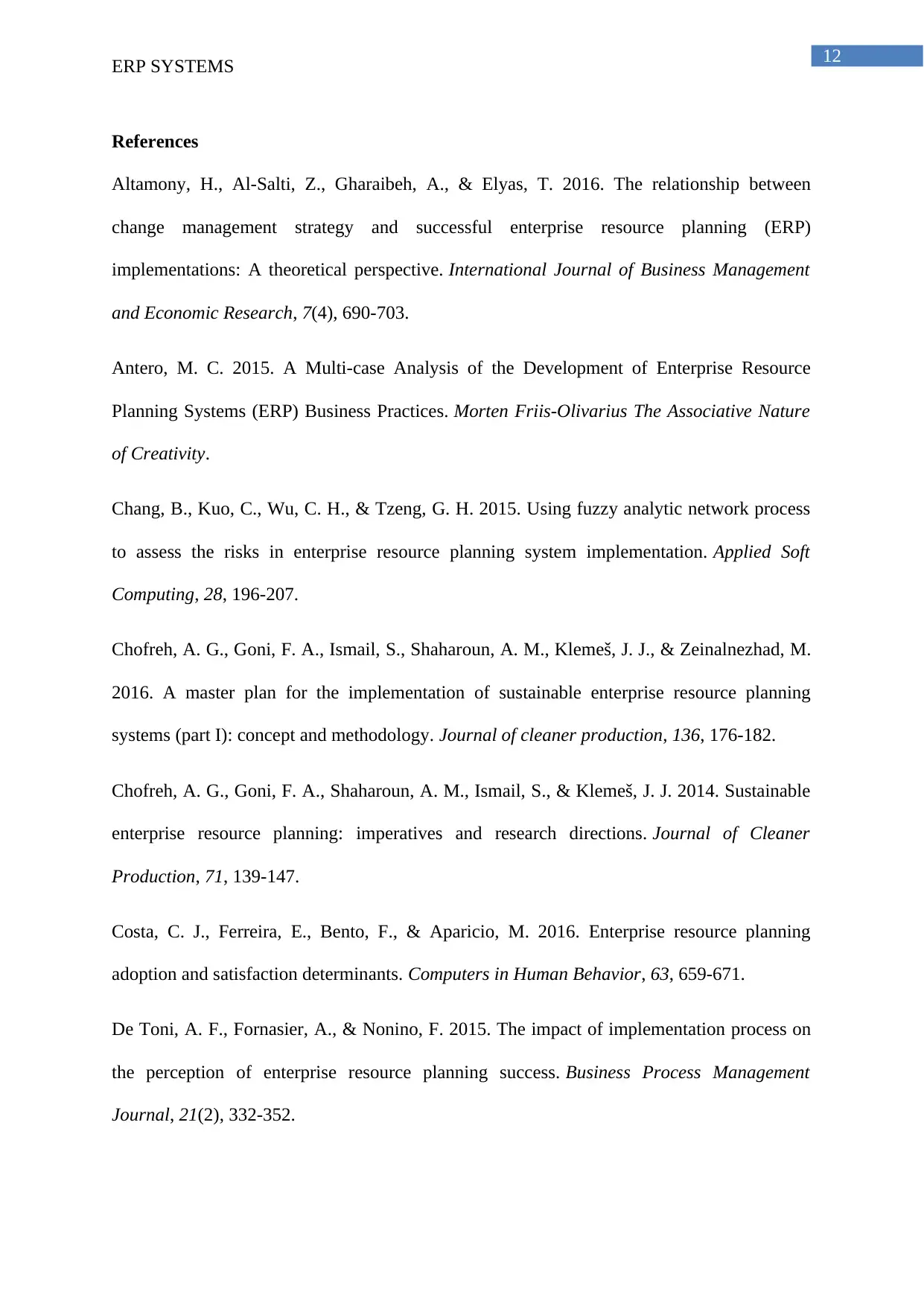
12
ERP SYSTEMS
References
Altamony, H., Al-Salti, Z., Gharaibeh, A., & Elyas, T. 2016. The relationship between
change management strategy and successful enterprise resource planning (ERP)
implementations: A theoretical perspective. International Journal of Business Management
and Economic Research, 7(4), 690-703.
Antero, M. C. 2015. A Multi-case Analysis of the Development of Enterprise Resource
Planning Systems (ERP) Business Practices. Morten Friis-Olivarius The Associative Nature
of Creativity.
Chang, B., Kuo, C., Wu, C. H., & Tzeng, G. H. 2015. Using fuzzy analytic network process
to assess the risks in enterprise resource planning system implementation. Applied Soft
Computing, 28, 196-207.
Chofreh, A. G., Goni, F. A., Ismail, S., Shaharoun, A. M., Klemeš, J. J., & Zeinalnezhad, M.
2016. A master plan for the implementation of sustainable enterprise resource planning
systems (part I): concept and methodology. Journal of cleaner production, 136, 176-182.
Chofreh, A. G., Goni, F. A., Shaharoun, A. M., Ismail, S., & Klemeš, J. J. 2014. Sustainable
enterprise resource planning: imperatives and research directions. Journal of Cleaner
Production, 71, 139-147.
Costa, C. J., Ferreira, E., Bento, F., & Aparicio, M. 2016. Enterprise resource planning
adoption and satisfaction determinants. Computers in Human Behavior, 63, 659-671.
De Toni, A. F., Fornasier, A., & Nonino, F. 2015. The impact of implementation process on
the perception of enterprise resource planning success. Business Process Management
Journal, 21(2), 332-352.
ERP SYSTEMS
References
Altamony, H., Al-Salti, Z., Gharaibeh, A., & Elyas, T. 2016. The relationship between
change management strategy and successful enterprise resource planning (ERP)
implementations: A theoretical perspective. International Journal of Business Management
and Economic Research, 7(4), 690-703.
Antero, M. C. 2015. A Multi-case Analysis of the Development of Enterprise Resource
Planning Systems (ERP) Business Practices. Morten Friis-Olivarius The Associative Nature
of Creativity.
Chang, B., Kuo, C., Wu, C. H., & Tzeng, G. H. 2015. Using fuzzy analytic network process
to assess the risks in enterprise resource planning system implementation. Applied Soft
Computing, 28, 196-207.
Chofreh, A. G., Goni, F. A., Ismail, S., Shaharoun, A. M., Klemeš, J. J., & Zeinalnezhad, M.
2016. A master plan for the implementation of sustainable enterprise resource planning
systems (part I): concept and methodology. Journal of cleaner production, 136, 176-182.
Chofreh, A. G., Goni, F. A., Shaharoun, A. M., Ismail, S., & Klemeš, J. J. 2014. Sustainable
enterprise resource planning: imperatives and research directions. Journal of Cleaner
Production, 71, 139-147.
Costa, C. J., Ferreira, E., Bento, F., & Aparicio, M. 2016. Enterprise resource planning
adoption and satisfaction determinants. Computers in Human Behavior, 63, 659-671.
De Toni, A. F., Fornasier, A., & Nonino, F. 2015. The impact of implementation process on
the perception of enterprise resource planning success. Business Process Management
Journal, 21(2), 332-352.
Paraphrase This Document
Need a fresh take? Get an instant paraphrase of this document with our AI Paraphraser
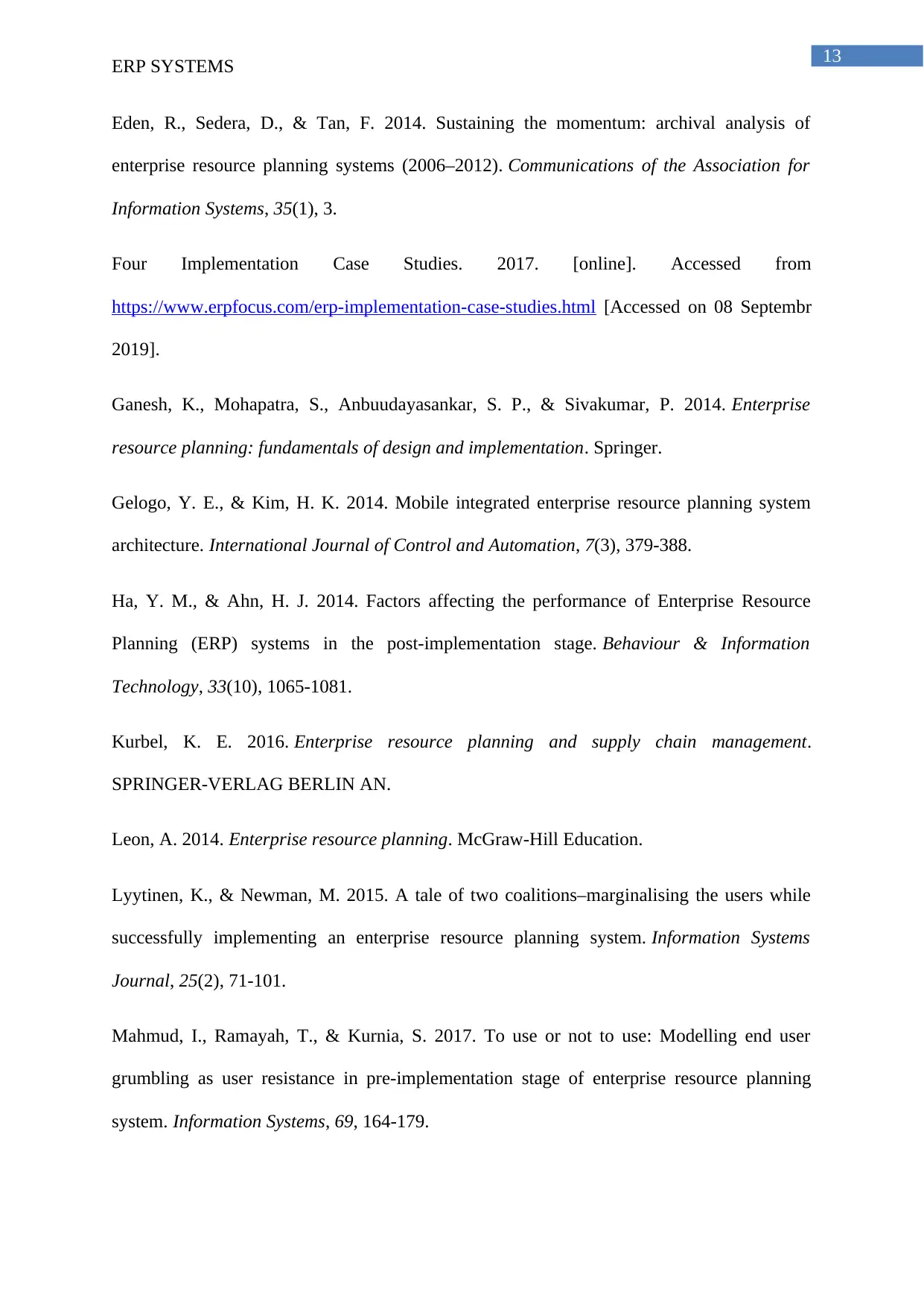
13
ERP SYSTEMS
Eden, R., Sedera, D., & Tan, F. 2014. Sustaining the momentum: archival analysis of
enterprise resource planning systems (2006–2012). Communications of the Association for
Information Systems, 35(1), 3.
Four Implementation Case Studies. 2017. [online]. Accessed from
https://www.erpfocus.com/erp-implementation-case-studies.html [Accessed on 08 Septembr
2019].
Ganesh, K., Mohapatra, S., Anbuudayasankar, S. P., & Sivakumar, P. 2014. Enterprise
resource planning: fundamentals of design and implementation. Springer.
Gelogo, Y. E., & Kim, H. K. 2014. Mobile integrated enterprise resource planning system
architecture. International Journal of Control and Automation, 7(3), 379-388.
Ha, Y. M., & Ahn, H. J. 2014. Factors affecting the performance of Enterprise Resource
Planning (ERP) systems in the post-implementation stage. Behaviour & Information
Technology, 33(10), 1065-1081.
Kurbel, K. E. 2016. Enterprise resource planning and supply chain management.
SPRINGER-VERLAG BERLIN AN.
Leon, A. 2014. Enterprise resource planning. McGraw-Hill Education.
Lyytinen, K., & Newman, M. 2015. A tale of two coalitions–marginalising the users while
successfully implementing an enterprise resource planning system. Information Systems
Journal, 25(2), 71-101.
Mahmud, I., Ramayah, T., & Kurnia, S. 2017. To use or not to use: Modelling end user
grumbling as user resistance in pre-implementation stage of enterprise resource planning
system. Information Systems, 69, 164-179.
ERP SYSTEMS
Eden, R., Sedera, D., & Tan, F. 2014. Sustaining the momentum: archival analysis of
enterprise resource planning systems (2006–2012). Communications of the Association for
Information Systems, 35(1), 3.
Four Implementation Case Studies. 2017. [online]. Accessed from
https://www.erpfocus.com/erp-implementation-case-studies.html [Accessed on 08 Septembr
2019].
Ganesh, K., Mohapatra, S., Anbuudayasankar, S. P., & Sivakumar, P. 2014. Enterprise
resource planning: fundamentals of design and implementation. Springer.
Gelogo, Y. E., & Kim, H. K. 2014. Mobile integrated enterprise resource planning system
architecture. International Journal of Control and Automation, 7(3), 379-388.
Ha, Y. M., & Ahn, H. J. 2014. Factors affecting the performance of Enterprise Resource
Planning (ERP) systems in the post-implementation stage. Behaviour & Information
Technology, 33(10), 1065-1081.
Kurbel, K. E. 2016. Enterprise resource planning and supply chain management.
SPRINGER-VERLAG BERLIN AN.
Leon, A. 2014. Enterprise resource planning. McGraw-Hill Education.
Lyytinen, K., & Newman, M. 2015. A tale of two coalitions–marginalising the users while
successfully implementing an enterprise resource planning system. Information Systems
Journal, 25(2), 71-101.
Mahmud, I., Ramayah, T., & Kurnia, S. 2017. To use or not to use: Modelling end user
grumbling as user resistance in pre-implementation stage of enterprise resource planning
system. Information Systems, 69, 164-179.
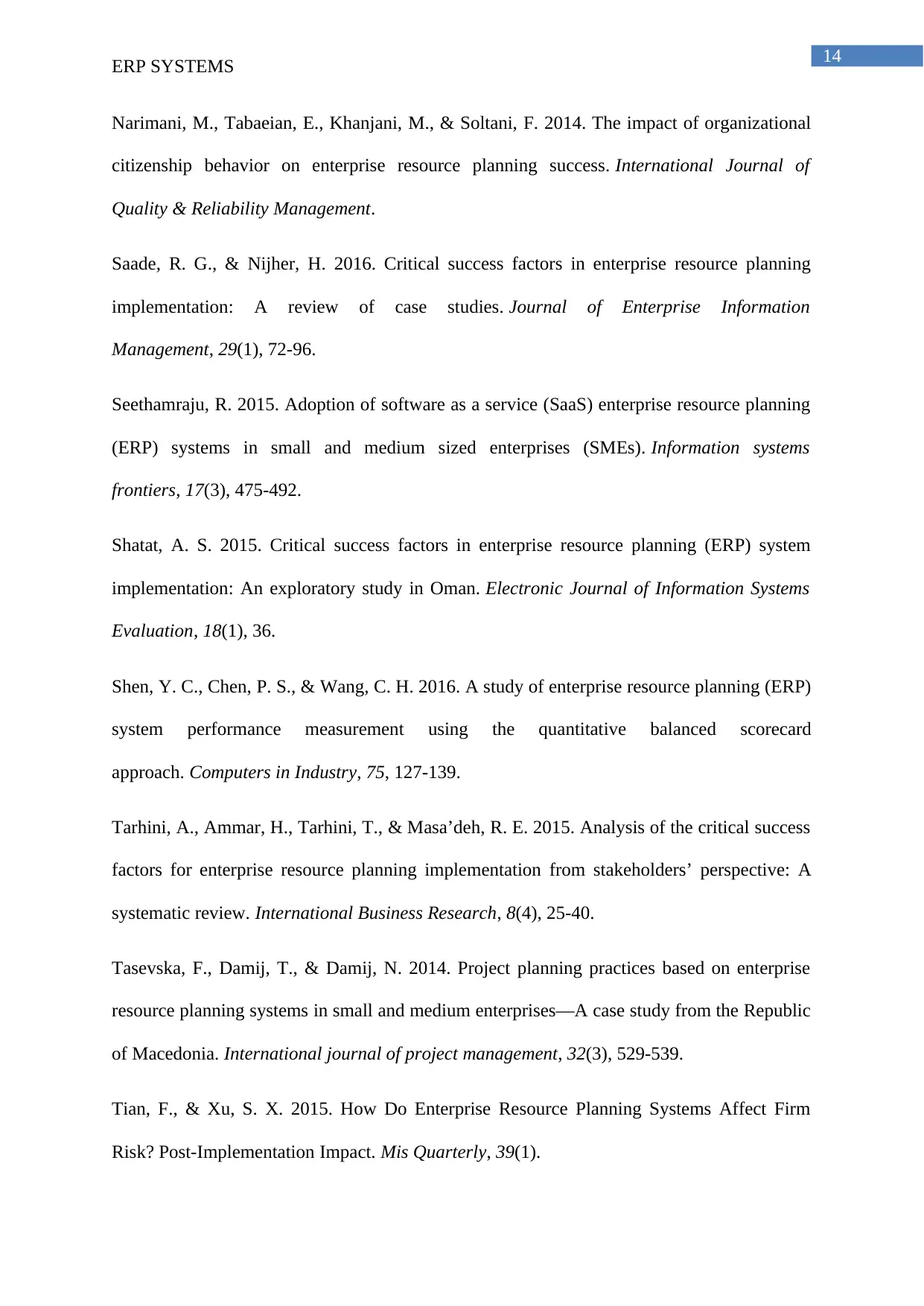
14
ERP SYSTEMS
Narimani, M., Tabaeian, E., Khanjani, M., & Soltani, F. 2014. The impact of organizational
citizenship behavior on enterprise resource planning success. International Journal of
Quality & Reliability Management.
Saade, R. G., & Nijher, H. 2016. Critical success factors in enterprise resource planning
implementation: A review of case studies. Journal of Enterprise Information
Management, 29(1), 72-96.
Seethamraju, R. 2015. Adoption of software as a service (SaaS) enterprise resource planning
(ERP) systems in small and medium sized enterprises (SMEs). Information systems
frontiers, 17(3), 475-492.
Shatat, A. S. 2015. Critical success factors in enterprise resource planning (ERP) system
implementation: An exploratory study in Oman. Electronic Journal of Information Systems
Evaluation, 18(1), 36.
Shen, Y. C., Chen, P. S., & Wang, C. H. 2016. A study of enterprise resource planning (ERP)
system performance measurement using the quantitative balanced scorecard
approach. Computers in Industry, 75, 127-139.
Tarhini, A., Ammar, H., Tarhini, T., & Masa’deh, R. E. 2015. Analysis of the critical success
factors for enterprise resource planning implementation from stakeholders’ perspective: A
systematic review. International Business Research, 8(4), 25-40.
Tasevska, F., Damij, T., & Damij, N. 2014. Project planning practices based on enterprise
resource planning systems in small and medium enterprises—A case study from the Republic
of Macedonia. International journal of project management, 32(3), 529-539.
Tian, F., & Xu, S. X. 2015. How Do Enterprise Resource Planning Systems Affect Firm
Risk? Post-Implementation Impact. Mis Quarterly, 39(1).
ERP SYSTEMS
Narimani, M., Tabaeian, E., Khanjani, M., & Soltani, F. 2014. The impact of organizational
citizenship behavior on enterprise resource planning success. International Journal of
Quality & Reliability Management.
Saade, R. G., & Nijher, H. 2016. Critical success factors in enterprise resource planning
implementation: A review of case studies. Journal of Enterprise Information
Management, 29(1), 72-96.
Seethamraju, R. 2015. Adoption of software as a service (SaaS) enterprise resource planning
(ERP) systems in small and medium sized enterprises (SMEs). Information systems
frontiers, 17(3), 475-492.
Shatat, A. S. 2015. Critical success factors in enterprise resource planning (ERP) system
implementation: An exploratory study in Oman. Electronic Journal of Information Systems
Evaluation, 18(1), 36.
Shen, Y. C., Chen, P. S., & Wang, C. H. 2016. A study of enterprise resource planning (ERP)
system performance measurement using the quantitative balanced scorecard
approach. Computers in Industry, 75, 127-139.
Tarhini, A., Ammar, H., Tarhini, T., & Masa’deh, R. E. 2015. Analysis of the critical success
factors for enterprise resource planning implementation from stakeholders’ perspective: A
systematic review. International Business Research, 8(4), 25-40.
Tasevska, F., Damij, T., & Damij, N. 2014. Project planning practices based on enterprise
resource planning systems in small and medium enterprises—A case study from the Republic
of Macedonia. International journal of project management, 32(3), 529-539.
Tian, F., & Xu, S. X. 2015. How Do Enterprise Resource Planning Systems Affect Firm
Risk? Post-Implementation Impact. Mis Quarterly, 39(1).
1 out of 15
Related Documents
Your All-in-One AI-Powered Toolkit for Academic Success.
+13062052269
info@desklib.com
Available 24*7 on WhatsApp / Email
![[object Object]](/_next/static/media/star-bottom.7253800d.svg)
Unlock your academic potential
© 2024 | Zucol Services PVT LTD | All rights reserved.





